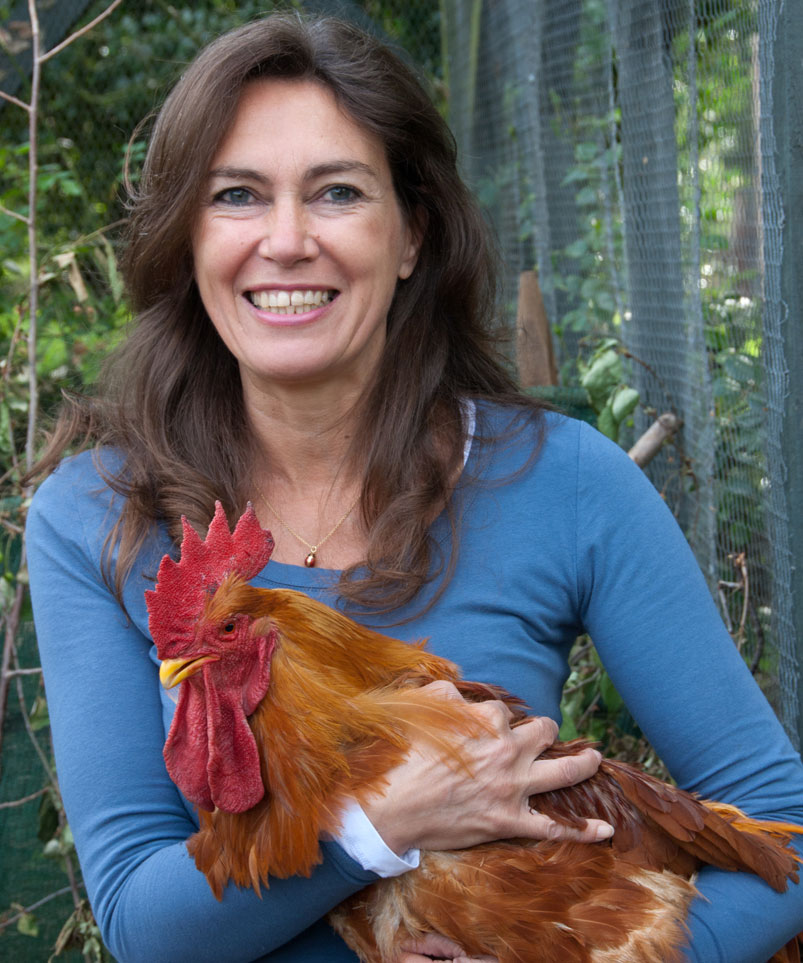A winter garden enhanced by decorative metalwork, brickwork and evergreens
This winter garden incorporates hand-crafted ironwork and brickwork to enhance the sculpted evergreen framework
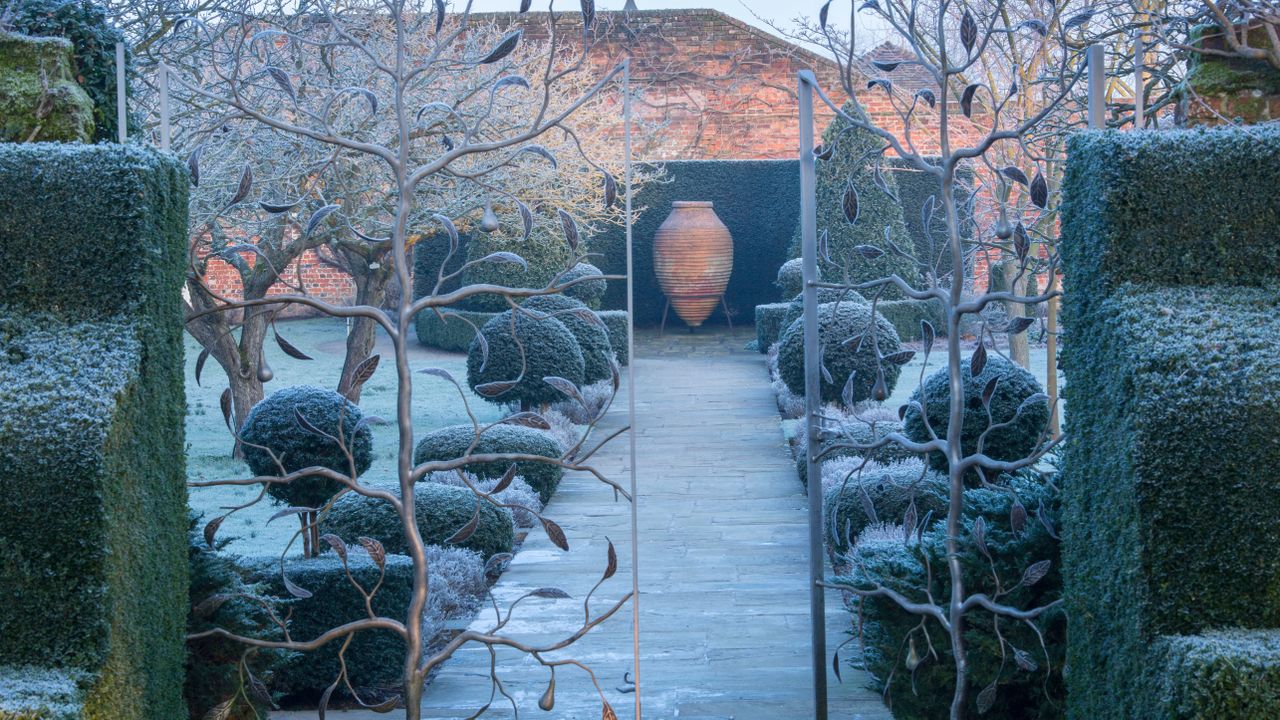
Caught in the grip of a hoar frost, the innovative design elements of this beautiful Manor House garden are brought to the forefront and spectacularly showcased.
The wintry scene is spellbinding, with decorative ironwork garden features and considered landscaping, combined with carefully sculpted topiary and clipped yew, highlighted against the frosty backdrop.
This dynamic garden has been planned so it offers life and energy in every season, and you can incorporate some of these elements into your own backyard ideas.
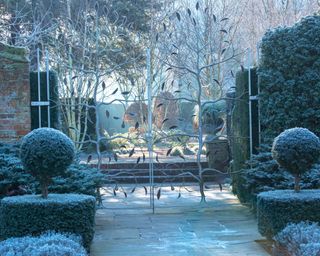
The successful design is the work of award-winning garden designer Julie Toll, who has been developing the gardens for the past 12 years, since the current owners moved in.
Working within the inherited footprint of the six-acre garden, Julie has ingeniously introduced a new Courtyard Garden in the former car parking area and up-styled and replanted existing areas.
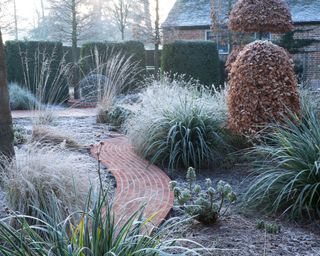
Hand-crafted brickwork detailing and more contemporary, hand-forged metalwork features have helped create new bones.
These new architecturally strong, decorative and practical features are most evident, laid bare, in winter and are among the many winter garden ideas to try.
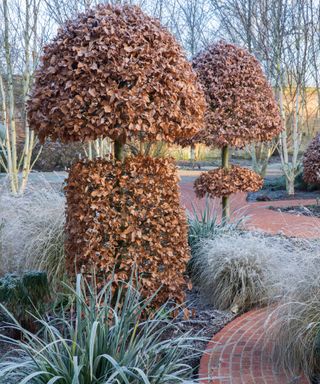
The new Courtyard Garden has uniquely designed brickwork path wending through dome-topped standard copper-beech topiary.
Warm and ruddy in winter, the bold silhouettes of the copper beech topiary contrast with a frosted, fountaining grass, molinia, before giving way to stands of winter-white Betula utilis subsp. jacquemontii.
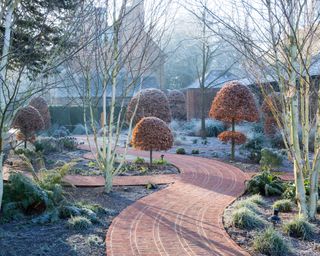
The landscaping materials complement the Manor’s mellow, old brickwork, which is also echoed in the color of the beech topiary – points to consider when incorporating original garden path ideas.
‘While the materials are quite traditional, in keeping with the 16th century property, the serpentine pathway, inlaid with hand thrown bricks, brings a modern, informal twist to the design,’ says Julie.
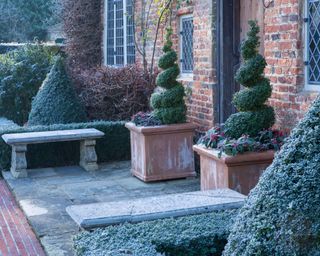
Julie has repeatedly used large terracotta urns and planters, 'to create a color cohesive design across the gardens’, demonstrating how useful containers planted with evergreens can be when planning a winter garden.
Many serve as focal points, drawing visitors from one garden room to the next. Planted with box pyramids and topiary swirls, the containers reinforce more formal characteristics of the garden.
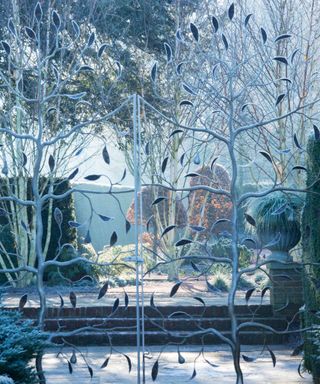
The introduction of a series of decorative metalwork garden gate ideas brings an exciting, more contemporary feel to the otherwise traditional architecture of the gardens.
Working with craftsman, Davey Boyall, founder and creative director of Arcangel metal work, Julie has helped realise bespoke designs.
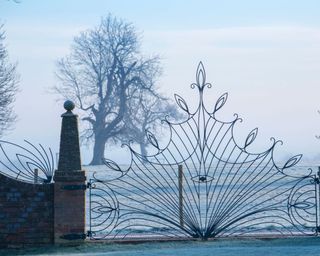
The Peacock Gates, a fantail of powder coated steel, frame the outlying parkland vista. Their design is a nod to the historic presence of peacocks in the grounds.
The main entrance gates fulfil the owner’s wish for something, ‘jewel-like but not too fussy’.
The Walled Garden’s entrance gates depict twin pear trees which lead into a revitalised orchard and wild flower meadow.

Water feature ideas also add another sensory element.
At the centre of a more recent, productive quadrangle, there’s an energetic spiralling steel fountain, ‘Spin’, by Davey Boyall.
In contrast, a quietly babbling font is tucked in among the fruit and vegetables, used for watering.

There is symmetry in the vegetable garden which is laid out in quadrangles in a sheltered corner of the walled garden.
Rectangular raised beds, ‘which makes for ease of netting brassicas and caged soft fruit,’ occupy the lower half of the vegetable garden and feature traditional brickwork paths or edging. Space-saving, espaliered fruit helps delineate the areas.
Victorian style cloches and terracotta rhubarb forces protect crops from subzero conditions.
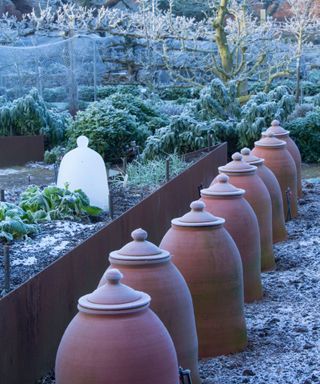
The remaining two quadrants are spanned by radiating, raised-bed wedges of ‘rusty’ Corten steel and dry stone walled herb beds.
Innovative and contemporary, yet in colour-keeping with the weathered brick walls and terracotta vessels, they reinforce the garden’s winter sepia.
They are screened and divided by stilted hornbeam hedges, among the best trees for privacy and screening.
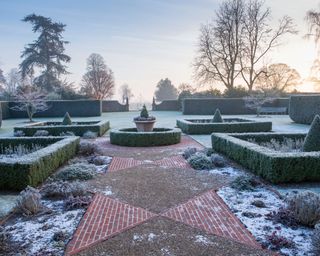
Diagonal brickwork resurfaces the pathways between the original formal box Parterre Garden at the front of the house, warming the previously monotone classical layout.
The concentrated geometry of frost-rimmed evergreen box, Buxus sempervirens, box hedges and shapes, provides winter structure and interest, when plants are least evident.
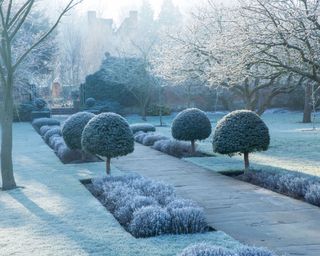
Considered planting and a coordinated, innovative use of hand-thrown brick and hand-forged steel have helped to subtly move a traditional garden forward.
These enduring hard landscaping elements shine particularly in winter, when the greater garden sleeps.
Sign up to the Homes & Gardens newsletter
Design expertise in your inbox – from inspiring decorating ideas and beautiful celebrity homes to practical gardening advice and shopping round-ups.

A creative freelance writer, stylist and photographer, Jacky Hobbs has created home and garden features for prestigious lifestyle magazines for over two decades.
An earlier career travelling the world as a fashion and homeware buyer developed her passion for lifestyle, interiors, vintage, travel and later gardens.
-
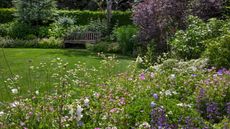 Landscape designers share the secrets to creating a romantic garden – for flamboyant fragrance, magical gateways, and cascading blooms to delight the senses
Landscape designers share the secrets to creating a romantic garden – for flamboyant fragrance, magical gateways, and cascading blooms to delight the sensesDiscover expert ways to design a romantic garden that has the perfect balance of defined lines, sumptuous blooms and finely crafted details
By Jill Morgan Published
-
 I tried using a Zodiac candle to cleanse my home of bad energy and kick-start my spring decluttering with surprising results
I tried using a Zodiac candle to cleanse my home of bad energy and kick-start my spring decluttering with surprising resultsThis home scenting idea is out of this world
By Ottilie Blackhall Published

